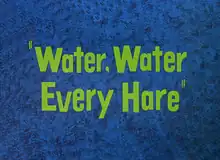| Water, Water Every Hare | |
|---|---|
 Title card | |
| Directed by | Charles M. Jones |
| Story by | Michael Maltese |
| Produced by | Edward Selzer (uncredited) |
| Starring | Mel Blanc John T. Smith (uncredited) |
| Music by | Carl Stalling |
| Animation by | Ben Washam Ken Harris Phil Monroe Lloyd Vaughan Richard Thompson (uncredited)[1] Harry Love (effects animation) |
| Layouts by | Robert Gribbroek |
| Backgrounds by | Philip DeGuard |
| Color process | Technicolor |
Production company | |
| Distributed by | Warner Bros. Pictures The Vitaphone Corporation |
Release date | April 19, 1952 (U.S.) |
Running time | 7:28 |
| Language | English |
Water, Water Every Hare is a 1952 Warner Bros. Looney Tunes cartoon directed by Chuck Jones.[2] The cartoon was released on April 19, 1952 and stars Bugs Bunny.[3] The short is a return to the themes of the 1946 cartoon Hair-Raising Hare and brings the monster Gossamer back to the screen.
The title is a pun on the line "Water, water, everywhere / Nor any drop to drink" from the poem The Rime of the Ancient Mariner, by Samuel Taylor Coleridge. The cartoon is available on Disc 1 of the Looney Tunes Golden Collection: Volume 1.
Plot
After being flooded out of his rabbit hole while sleeping during a heavy storm, Bugs winds up in the castle of an "evil scientist" , a caricature of Boris Karloff, who needs a living brain to complete the construction of his giant robot. Bugs awakens with a mummy resting on top of him, then leaps in terror around the room and flees down the hall. The annoyed scientist dispatches an orange,[4] hairy monster he calls "Rudolph" to retrieve him, with the promise of being rewarded with a spider goulash.
Bugs keeps running until a trap door opens to reveal a water pit below with hungry crocodiles snapping their jaws. He steps backward while praying aloud and bumps into "Rudolph". Bugs quickly makes as a gabby hairdresser, giving the monster a new hairdo. He retrieves dynamite sticks from the "high explosives" room and puts them in the monster's hair to mimic curlers. He lights them and runs off just before the explosion, which leaves the monster with a bald head.
The enraged monster ties up his hair to cover the bald spot and darts after Bugs. The chase leads to a chemical storage room, where Bugs uses "vanishing fluid" to gain invisibility. As the monster looks around, invisible Bugs slams a trash can over the monster's head and whacks it with a mallet. Then Bugs pulls the rug out from beneath the monster's feet, causing him to crash on the floor. For the coup de grâce, Bugs pours "reducing oil" on the dazed monster, shrinking him as he lets out a roar. Putting on a suit and grabbing two suitcases, the monster enters a mouse hole, kicks its resident out and slams the door, which bears a sign saying "I QUIT!". The mouse drops a bottle labeled "XXX" (liquor) and says, "I quit, too!"
Bugs, still invisible, eats a carrot in satisfaction of his victory. Suddenly, the mad scientist makes him visible with "hare restorer", insisting the rabbit hand over his brain. When Bugs refuses, the scientist throws a hatchet straight at him. Bugs ducks the axe which smashes open a large bottle of ether, resulting in the fumes drugging both Bugs and the scientist. In slow motion, the groggy scientist gives chase until Bugs lethargically trips him, causing him to drift down to the floor and fall asleep.
Still slowly, Bugs prances away from the castle and across the horizon, trips over a rock and, just like the scientist, falls asleep, landing in a stream which leads Bugs straight back into his flooded hole. Suddenly waking up, he tells himself it must have been a nightmare, until the miniature monster passes by on a rowboat declaring "Oh yeah? That's what you think!", leaving Bugs perplexed.
Cast
- Mel Blanc as Bugs Bunny, Gossamer ("Rudolph") and Mouse
- John T. Smith as Scientist (uncredited)
See also
References
- ↑ "Animation Breakdowns #35". Retrieved 6 January 2021.
- ↑ Beck, Jerry; Friedwald, Will (1989). Looney Tunes and Merrie Melodies: A Complete Illustrated Guide to the Warner Bros. Cartoons. Henry Holt and Co. p. 234. ISBN 0-8050-0894-2.
- ↑ Lenburg, Jeff (1999). The Encyclopedia of Animated Cartoons. Checkmark Books. pp. 60–62. ISBN 0-8160-3831-7. Retrieved 6 June 2020.
- ↑ "Gossamer".